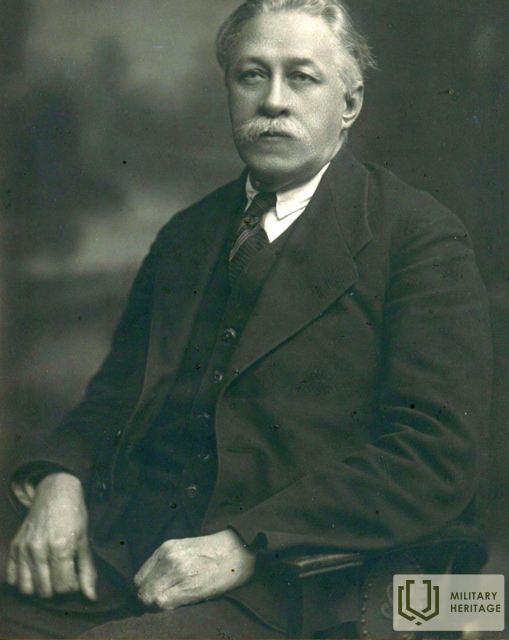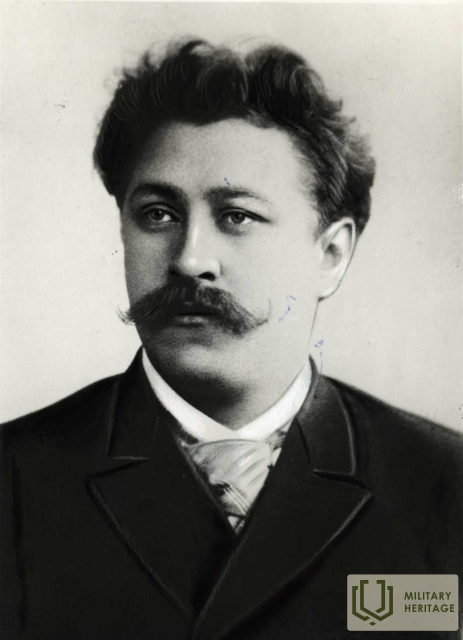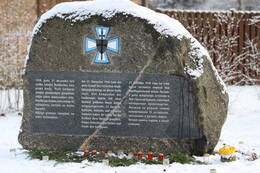Peteris Stucky I WW1, I Nepriklausomybės karai
Pēteris Stučka (1865–1932) – teisininkas, politikas, publicistas, knygnešys, vienas iš „Naujosios srovės“ lyderių, kelių socialistinių ir komunistinių spaudos leidinių redaktorius.
Gimė 1865 m. Koknesės parapijos „Vecbirzniekuose“ pasiturinčioje ūkininkų šeimoje. Stučkos tėvas Janis Stučka jaunystėje buvo plaustais, vėliau dirbo mokytoju ir kunigu, o vedęs tapo didelio ūkio savininku.
1879 m. rudenį jis įstojo į Rygos vokiečių gimnaziją, kur susipažino su Jāniu Pliekšānu. 1884 m. abu pradėjo studijuoti Sankt Peterburgo universitete, prisijungdami prie universiteto latvių studentų grupės. Stučka baigė universitetą 1888 m., grįžo į Rygą ir ėmėsi Latvijos demokratinio laikraščio „Dienas Lapa“ redaktoriaus pareigų. 1897 m. vasarą „Dienas Lapa“ buvo laikinai uždaryta, o pats Stučka suimtas. Iki 1898 m. sausio mėn. Stučka kalėjo Vidžemės gubernijos kalėjime Rygoje.
Tada jis buvo ištremtas į Vitebską. Po 1905 m. revoliucijos numalšinimo grįžo į Rygą. Nuo 1907 m. dirbo teisininku Sankt Peterburge, įkūrė privačią leidyklą „Dzirkstele“, pradėjo leisti marksizmą populiarinantį žurnalą latvių kalba (žurnalas kelis kartus keitė pavadinimą – „Atvases“, „Jaunais Pūrs“, „Dzirkstele“, „Ciba“ ir kt.), kuriame taip pat publikavo savo apmąstymus įvairiomis temomis. Jis taip pat buvo Latvijos Socialistinės Tarybų Respublikos vyriausybės (1919 m.) vadovas, kuri buvo 1918 m. gruodžio 4 d. įvykių rezultatas: Rusijoje buvo įkurta Latvijos Tarybų vyriausybė, kuri gruodžio 17 d. išplatino Latvijos Tarybų vyriausybės manifestą, kuriame paskelbė savo pagrindinius tikslus. Latvijos Tarybų vyriausybei vadovavo Pēteris Stučka, kuris gruodžio 21 d. atvyko į Valką iš Pskovo. Raudonoji armija, įskaitant Latvijos šaulių pulkus, sparčiai artėjo prie Rygos. 1919 m. sausio 2 d. Latvijos laikinoji vyriausybė, vadovaujama Kārlio Ulmanio, paliko vietą Pēteriui Stučkui ir jo sovietinei Latvijos vyriausybei.
P. Stučkos vyriausybė nusprendė duoti Rusijos bendražygiams pavyzdinę pamoką, kaip kurti socializmą. Jį apėmė įsitikinimas, kad „Latvijos darbo komuna“ turi visas galimybes tapti komunistų pavyzdžiu ne tik Rusijoje, bet galbūt net ir Europos mastu. Latvijos proletariatui buvo lemta būti „fakelu revoliucinėje parako statinėje“. Tai buvo reformų teroro ir radikalizmo, patirto Sovietų Latvijoje nuo 1919 m. sausio iki gegužės, šaltinis, kurio nebuvo galima pastebėti net Rusijoje. Stučka ir jo bendražygiai skubėjo kuo greičiau pasiekti taip trokštamą socializmą, tačiau nukentėjo, nes greitai prarado gyventojų viltis ir paramą, o tai lėmė Sovietų Latvijos žlugimą ir visišką sunaikinimą Latvijos nepriklausomybės karo metu. Pēteris Stučka atliko savo vaidmenį, tačiau taip politiškai prastai, kad iš gerbiamo Naujosios srovės nario virto nekenčiamu komunistu.
Vėliau P.Stučka buvo SSRS Aukščiausiojo Teismo pirmininkas (1923 m.). 1931 m. Stučka buvo paskirtas Maskvos tarybinės teisės instituto direktoriumi. Aizkrauklės miestas, Latvijos valstybinis universitetas ir Tērbato gatvė Rygoje buvo pavadinti Pēterio Stučkos vardu. Pēteris Stučka mirė 1932 m. sausio 25 d. Maskvoje ir yra palaidotas Raudonojoje aikštėje prie Kremliaus sienos.
Daugiau informacijos šaltinių
LU LLRI. Pēteris Stučka. Prieiga: https://literatura.lv/lv/person/Peteris-Stucka/872473 [žiūrėta 2021 05 06].
Latvijos karo muziejus. Asmenybės ir jų pasiekimai Latvijos Nepriklausomybės karo metu. Prieinama: http://www.karamuzejs.lv/lv/Petnieciba/publikacijas/12_Petnieciba_Neatkaribaskara_personibas_KP_201912.aspx [žiūrėta 2021-05-06].
Susijusi laiko juosta
Susijusios vietos
Paminklas pirmajam mūšiui už Latvijos nepriklausomybę
Adresas: Inčukalns, Atmodas g. 2.
2016 m. liepos 3 d. buvo atidengtas paminklas pirmajam mūšiui už Latvijos nepriklausomybę, skirtas Latvijos landesverui (Die Lettländische Landeswehr), kuriame vietos baltų vokiečiai, rusai ir latviai, tuo metu buvę abiejų pusių daliniuose, gynė naujai įkurtą valstybę nuo bolševikų Raudonosios Armijos. Brolių kapų komiteto pirmininkas Eiženas Upmanis tuo metu padarė išvadą, kad tai galėtų būti pirmasis paminklas jungtinėms Latvijos ir Baltijos vokiečių pajėgoms mūšio memorialuose už kapinių ribų. Tuo metu Latvijos landesvero latvių dalinių vadu buvo paskirtas pulkininkas leitenantas Oskaras Kalpaksas, iš kurio dalinių Laisvės kovų metu išaugo ir susiformavo vėlesnė Latvijos armija.
1918 m. visa dabartinės Latvijos teritorija pateko į Vokietijos imperijos ir jos kariuomenės rankas. Tačiau 1918 m. vasaros pabaigoje ir rudenį padėtis ėmė sparčiai keistis prieš Vokietiją ir tapo aišku, kad tik laiko klausimas, kada Vokietija bus priversta pripažinti pralaimėjimą Pirmajame pasauliniame kare. Rusijos imperija, kurios dalimi Latvija buvo iki Pirmojo pasaulinio karo, nustojo egzistuoti anksčiau, po 1917 m. vasario ir spalio revoliucijų. 1918 m. lapkričio 18 d. buvo paskelbta Latvijos Respublika. Vokietijos kariuomenė, kuri po 1918 m. lapkričio 11 d. paliaubų su Antantės valstybėmis buvo dislokuota Latvijos teritorijoje, nebebuvo motyvuota tolesniems karo veiksmams, ir dauguma jos kareivių tiesiog norėjo grįžti į tėvynę.
Tokiomis aplinkybėmis buvo akivaizdu, kad Latvijos gynyba pirmiausia priklausė nuo pačių Latvijos gyventojų suformuotos nacionalinės gvardijos. Iš pradžių, dėl savo išsilavinimo ir santykinai didesnio gebėjimo savarankiškai organizuotis, didžiausią iniciatyvą formuojant tokią nacionalinę gvardiją rodė Latvijoje gyvenantys Baltijos vokiečiai. Į nacionalinę gvardiją įstojo ir Rusijos kareiviai. Siekdama užtikrinti nacionalinės gvardijos aprūpinimą uniformomis, ginklais ir kitais reikalingais ištekliais, Latvijos laikinoji vyriausybė 1918 m. gruodžio 7 d. sudarė susitarimą su Vokietijos atstovu Augustu Vinnigu, numatantį nacionalinės gvardijos aprūpinimą iš Latvijos teritorijoje esančių Vokietijos armijos rezervų. Šiame susitarime, be kita ko, buvo nurodyta, kad ši nacionalinė gvardija, oficialiai vadinama „Latvijas zemessardze“ arba vokiškai „die Lettländische Landeswehr“, bus Latvijos Respublikos ginkluotosios pajėgos.
Latvijos nacionalinė gvardija susidūrė su dviem Latvijos raudonųjų šaulių pulkais (t. y. maždaug 2000–3000 karių), kurie anksčiau buvo patyrę Pirmajame pasauliniame kare ir Rusijos pilietiniame kare. Nepaisant Raudonosios armijos patirties ir skaitinės persvaros, Latvijos nacionalinė gvardija dvi dienas laikė Inčukalną įnirtingose kovose, kol galiausiai 1919 m. sausio 1 d. vakarą, norėdama išvengti apsupties, buvo priversta trauktis, praradusi 43 žuvusius ir kelis sužeistuosius, kurių dauguma buvo bolševikų sučiupti, kur žuvo arba mirė nuo bado ar ligų.
Autorius: Artis Buks. Medžiaga: lauko akmuo. Paminklas pagamintas iš didelio monolitinio akmens, rasto Ruļļuose netoli Jelgavos.








